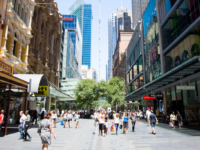Australian retail sales slightly rose year over year in May as shoppers took advantage of early end-of-financial-year (EOFY) promotions and sales events.
Australian Bureau of Statistics (ABS) data showed that retail sales totaled $35.94 billion during the month.
“Retail businesses continue to rely on discounting and sales events to stimulate discretionary spending, following restrained spending in recent months,” Robert Ewing, ABS head of business statistics, said.
Food retail sales grew 3.0 per cent to $14.36 billion while household goods sales increased 0.1 per cent to $5.73 billion.
Meanwhile, clothing, footwear and personal accessory retailing fell 0.2 per cent to $2.98 billion. Department store sales also declined 1.7 per cent to $1.90 billion.
Cafes, restaurants and takeaway climbed 0.9 per cent to $5.39 billion while other retailing rose 3 per cent to $5.61 billion.
“These early promotions and sales follow the same trend we saw in November last year, when retailers offered large Black Friday sales four weeks out from the actual shopping event,” Lindsay Carroll, interim CEO at National Retail Association, said. “While the sales boost is a positive indicator for consumer sentiment, it doesn’t change the desperate landscape retail business owners are currently facing.”
Among all states, Tasmania led the retail sales growth at 4.4 per cent. Western Australia grew 3.5 per cent and the Northern Territory climbed 2.9 per cent. Queensland and Victoria rose 2.6 per cent and 1.7 per cent, respectively.
South Australia made a marginal growth of 1.3 per cent, as well as the Australian Capital Territory at 1 per cent. New South had the least growth of 0.4 per cent.
“While food spending remains constant as a staple, there has been a shift towards more affordable and value-oriented products in recent months,” Fleur Brown, chief industry affairs officer at the Australian Retailers Association, said.
“The discretionary categories are being hit the hardest, as seen with household goods, clothing and department stores,” Brown added. “The ongoing cost-of-living pressures, interest rate ramifications and increased cost of doing business make it a challenging period – particularly for those in the discretionary retail sector and small to medium size businesses.”
This story first appeared on our sister publication Inside Retail














